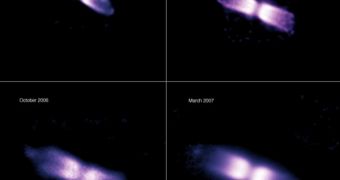Last year, astronomers investigating the regular variable star V445 Puppis, in the constellation Puppis, proposed that the celestial body was well on its way towards becoming a fully-fledged type 1a supernova. Now, a new paper challenges that claim and says that transformation is impossible.
Experts started taking interest in the star back in December 2000, when telescopes detected the body undergoing a peculiar nova change. In other words, it detonated in a powerful blast that did not however destroy its surface.
Nova events are not at all uncommon in the Universe. They occur very often in binary star systems, especially ones in which a white dwarf revolves around a red giant, or other type of large star.
Interactions between the two bodies channel matter from the surface of the most massive star in the system into an accretion disk around the white dwarf, which continuously increases its mass.
Once a certain threshold is reached, the excess matter is expelled in a violent explosion, which allows the white dwarf to become stable again. But V445 Puppis does not seem to abide by the same mechanisms, astronomers say.
In early November 2000, the star began its nova phase, which peaked on November 29. Then the star's apparent brightness subsided again. A team of experts then proposed that the binary system is about to turn supernova.
This conclusion was based on the knowledge of how this particular system is set up. The primary star is a white dwarf, and it shares a gas envelope with its partner. As such, experts were right to propose their conclusions.
But more in-depth spectroscopic observations revealed that the nova event did not produce the usual helium emission, that is characteristic to this type of event. The ejecta material that was released during the explosion actually lacked important helium concentrations, which is highly unusual.
What the experts discovered in the new study was that the nova actually released heavier elements in space, including iron, calcium, carbon, sodium, and oxygen, Universe Today reports.
Following the nova, the binary star system has become completely enveloped in dust. It is no longer visible in optical wavelengths. Only infrared or radio waves can now penetrate to its core.
The new research was led by expert V. P. Goranskij, who is based at the Moscow University. His main conclusion is that the nova basically canceled all chances the system had of actually going supernova.
In other words, V445 Puppis would have had all the conditions for turning supernova in the future, had it only continued to accrete enough matter on its white dwarf.

 14 DAY TRIAL //
14 DAY TRIAL //